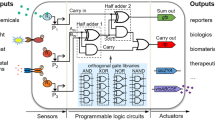Abstract
In this paper, we review an emerging engineering discipline to programcell behaviors by embedding synthetic gene networks that performcomputation, communications, and signal processing. To accomplishthis goal, we begin with a genetic component library and a biocircuitdesign methodology for assembling these components into compoundcircuits. The main challenge in biocircuit design lies in selectingwell-matched genetic components that when coupled, reliably producethe desired behavior. We use simulation tools to guide circuitdesign, a process that consists of selecting the appropriatecomponents and genetically modifying existing components until thedesired behavior is achieved. In addition to such rational design, wealso employ directed evolution to optimize genetic circuitbehavior. Building on Nature's fundamental principle of evolution,this unique process directs cells to mutate their own DNA until theyfind gene network configurations that exhibit the desired systemcharacteristics. The integration of all the above capabilities infuture synthetic gene networks will enable cells to performsophisticated digital and analog computation, both asindividual entities and as part of larger cell communities. Thisengineering discipline and its associated tools will advance thecapabilities of genetic engineering, and allow us to harness cells fora myriad of applications not previously achievable.
Similar content being viewed by others
References
Barkai N and Leibler S (1997) Robustness in simple biochemical network. Nature 403: 168–171
Bassler BL (1999) How bacterial talk to each other: regulation of gene expression by quorum sensing. Current Opinion in Microbiology 2: 582–587
Basu S, Karig D and Weiss R (2002) Engineered processing of cells: towards molecular concentration band detection. In: Eighth International Meeting on DNA-Based Computers. Sapporo, Japan
Becskei A and Serrano L (2000) Engineering stability in gene networks by autoregulation. Nature 405: 590–593
Burlage RS, Fisher RL, DiBenedetto J and Maston J (2000) Gene System for the field detection of explosive. Second International Symposium on Biotechnology for Conservation of the Environment
De Jong H (2002) Modeling and simulation of genetic regulatory systems: a literature review. Journal of Computational Biology 9(1): 67–103
Elowitz M and Leibler S (2000) A synthetic oscillatory network of transcriptional regulators. Nature 403: 335–338
Elowitz MB, Levine AJ, Siggia ED and Swain P (2002) Stochastic gene expression in a single cell. Science 297: 1183–1186
Engebrecht J, Nealson KH and Silverman M (1983) Bacterial bioluminescence: isolation and genetic analysis of the functions from Vibrio fischeri. Cell 32: 773–781
Gardner T, Cantor R and Collins J (2000) construction of a genetic toggle switch in Escherichia coli'. Nature 403: 339–342
Gillespie DT (1977) Exact stochastic simulation of coupled chemical reactions. Journal of Physical Chemistry 81(25): 2340–2361
Greenberg E (1997) Quorum sensing in gram-negative bacteria. In: ASM News, Vol. 63, pp. 371–377
Guet CC, Elowitz MB, Hsing W and Leibler S (2002) Combinatorial synthesis of genetic networks. Nature 296: 1466–1470
Hanzelka BL and Greenberg EP (1996) Quorum sensing in Vibrio fischeri: evidence that Sadenosylmethionine is the amino acid substrate for autoinducer synthesis. J. Bacteriol. 178: 5291–5294
Hastings JW and Nealson KH (1977) Bacterial bioluminescence. Annual Review of Microbiology 31: 549–595
Hendrix RW (1983) Lambda II. Cold Spring Harbor Press, Cold Spring Harbor, NY
Kaplan HB and Greenberg EP (1985) Diffusion of autoinducer is involved in regulation of the Vibrio fischeri luminescence system. J. Bacteriol. 163: 1210–1214
Kauffman SA (1969) Metabolic stability and epigenesis in randomly constructed genetic nets. Journal of Theoretical Biology 22: 437
McAdams HH and Arkin A (1998) Simulation of Prokaryotic genetic circuits. Annu. Rev. Biophys. Biomol. Struc. 27: 199–224
McMillen D, Kopell N, Hasty J and Collin JJ (2002) Synchronizing genetic relaxation oscillators by intercell signaling. Proceedings of the National Academy of Science USA 99: 679–684
Ptashne M (1986) A Genetic Switch: Phage Lambda and Higher Organisms, 2 ed. Cell Press and Blackwell Scientific Publications, Cambridge, MA
Rao CV and Arkin AP (2001) Control motifs for intracellular regulatory networks. Annu. Rev. Biomed. Eng 3: 391–419
Shapiro HM (1995) Practical Flow Cytometry, 3rd ed. Wiley-Liss, New York
von Dassow G, Meir E, Munro E and Odell G (2000) The segment polarity network is a robust development model. Nature 406: 188–192
Weiss R (2001) Cellular computation and communications using engineered genetic regulatory networks. Ph.D. thesis, Massachusetts Institute of Technology
Weiss R and Basu S (2002) The device physics of cellular logic gates. In: NSC-1: The First Workshop of Non-Silicon Computing. Boston, MA
Weiss R, Homsy G and Knight TF Jr. (1999) Toward in-vivo digital circuits. In: Dimacs Workshop on Evolution as Computation. Princeton, NJ
Weiss R and Knight TF Jr. (2002) Engineered communications for microbial robotics. In: DNA6: Sixth International Workshop on DNA-based computers, DNA2000, pp. 1–16. Springer-Verlag, Leiden, The Netherlands
Yokobayashi Y, Weiss R and Arnold FH (2002) Directed evolution of a genetic circuit. Proceedings of the National Academy of Science USA 99: 16587–16591
Author information
Authors and Affiliations
Corresponding author
Rights and permissions
About this article
Cite this article
Weiss, R., Basu, S., Hooshangi, S. et al. Genetic circuit building blocks for cellular computation, communications, and signal processing. Natural Computing 2, 47–84 (2003). https://doi.org/10.1023/A:1023307812034
Issue Date:
DOI: https://doi.org/10.1023/A:1023307812034




